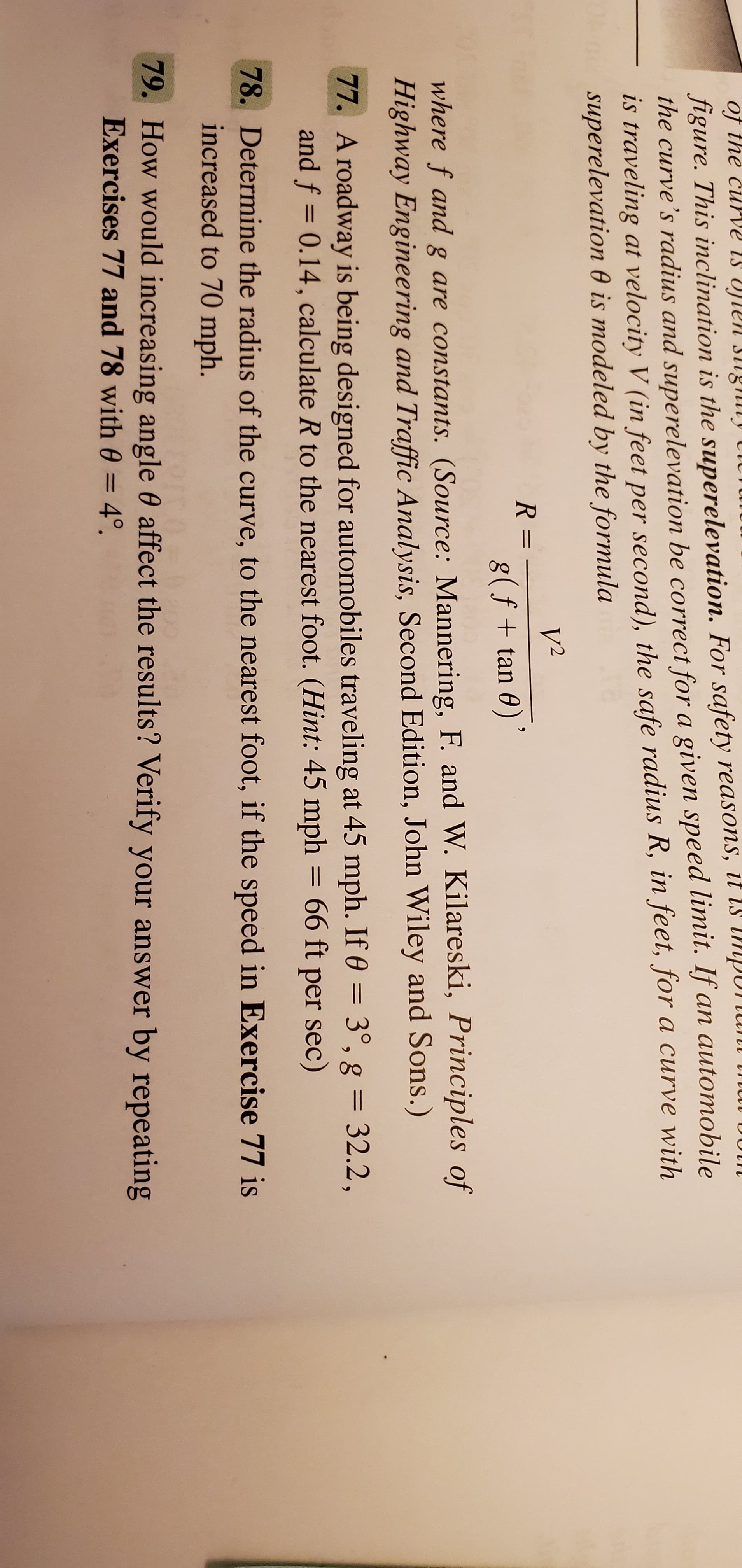of the curve is vien signllly CiCTunt figure. This inclination is the superelevation. For safety reasons, it iS im. the curve's radius and superelevation be correct for a given speed limit. If an automobile is traveling at velocity V (in feet per second), the safe radius R, in feet, for a curve with superelevation 0 is modeled by the formula V2 %3D 8(f + tan 0)' where f and g are constants. (Source: Mannering, F. and W. Kilareski, Principles of Highway Engineering and Traffic Analysis, Second Edition, John Wiley and Sons.) 77. A roadway is being designed for automobiles traveling at 45 mph. If 0 = 3°, g = 32.2, and f = 0.14, calculate R to the nearest foot. (Hint: 45 mph = 66 ft per sec) 78. Determine the radius of the curve, to the nearest foot, if the speed in Exercise 77 is increased to 70 mph. 79. How would increasing angle 0 affect the results? Verify your answer by repeating Exercises 77 and 78 with 0 = 4°.
of the curve is vien signllly CiCTunt figure. This inclination is the superelevation. For safety reasons, it iS im. the curve's radius and superelevation be correct for a given speed limit. If an automobile is traveling at velocity V (in feet per second), the safe radius R, in feet, for a curve with superelevation 0 is modeled by the formula V2 %3D 8(f + tan 0)' where f and g are constants. (Source: Mannering, F. and W. Kilareski, Principles of Highway Engineering and Traffic Analysis, Second Edition, John Wiley and Sons.) 77. A roadway is being designed for automobiles traveling at 45 mph. If 0 = 3°, g = 32.2, and f = 0.14, calculate R to the nearest foot. (Hint: 45 mph = 66 ft per sec) 78. Determine the radius of the curve, to the nearest foot, if the speed in Exercise 77 is increased to 70 mph. 79. How would increasing angle 0 affect the results? Verify your answer by repeating Exercises 77 and 78 with 0 = 4°.
Algebra & Trigonometry with Analytic Geometry
13th Edition
ISBN:9781133382119
Author:Swokowski
Publisher:Swokowski
Chapter3: Functions And Graphs
Section3.6: Quadratic Functions
Problem 36E
Related questions
Concept explainers
Ratios
A ratio is a comparison between two numbers of the same kind. It represents how many times one number contains another. It also represents how small or large one number is compared to the other.
Trigonometric Ratios
Trigonometric ratios give values of trigonometric functions. It always deals with triangles that have one angle measuring 90 degrees. These triangles are right-angled. We take the ratio of sides of these triangles.
Question
A roadway is being designed for automobiles traveling at 45 mph. If theta=3°, g= 32.2, and f= 0.14, calculate R to the nearest foot. (Hint: 45 mph= 66 feet Per sec)

Transcribed Image Text:of the curve is vien signllly CiCTunt
figure. This inclination is the superelevation. For safety reasons, it iS im.
the curve's radius and superelevation be correct for a given speed limit. If an automobile
is traveling at velocity V (in feet per second), the safe radius R, in feet, for a curve with
superelevation 0 is modeled by the formula
V2
%3D
8(f + tan 0)'
where f and g are constants. (Source: Mannering, F. and W. Kilareski, Principles of
Highway Engineering and Traffic Analysis, Second Edition, John Wiley and Sons.)
77. A roadway is being designed for automobiles traveling at 45 mph. If 0 = 3°, g = 32.2,
and f = 0.14, calculate R to the nearest foot. (Hint: 45 mph = 66 ft per sec)
78. Determine the radius of the curve, to the nearest foot, if the speed in Exercise 77 is
increased to 70 mph.
79. How would increasing angle 0 affect the results? Verify your answer by repeating
Exercises 77 and 78 with 0 = 4°.
Expert Solution
This question has been solved!
Explore an expertly crafted, step-by-step solution for a thorough understanding of key concepts.
This is a popular solution!
Trending now
This is a popular solution!
Step by step
Solved in 3 steps with 3 images

Knowledge Booster
Learn more about
Need a deep-dive on the concept behind this application? Look no further. Learn more about this topic, trigonometry and related others by exploring similar questions and additional content below.Recommended textbooks for you

Algebra & Trigonometry with Analytic Geometry
Algebra
ISBN:
9781133382119
Author:
Swokowski
Publisher:
Cengage

Functions and Change: A Modeling Approach to Coll…
Algebra
ISBN:
9781337111348
Author:
Bruce Crauder, Benny Evans, Alan Noell
Publisher:
Cengage Learning

Algebra & Trigonometry with Analytic Geometry
Algebra
ISBN:
9781133382119
Author:
Swokowski
Publisher:
Cengage

Functions and Change: A Modeling Approach to Coll…
Algebra
ISBN:
9781337111348
Author:
Bruce Crauder, Benny Evans, Alan Noell
Publisher:
Cengage Learning